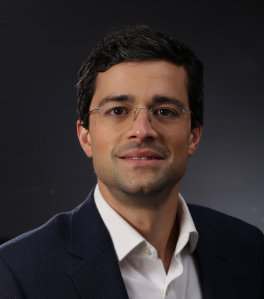From biosimilars and gene therapies to bionic eyes, the next era of retinal care is poised to be game-changing
For the last decade, antivascular endothelial growth factor (anti-VEGF) therapies have dominated retinal care, but now the treatment landscape is booming with fresh innovations. From more affordable biosimilars and extended-release treatments to gene therapy and retinal prosthetics, it’s clear that the future of vitreoretinal treatment is teeming with potential.
As 2025 looms, the future of vitreoretinal treatment promises a mix of breakthroughs and buzzworthy advancements that could reshape how we manage retinal diseases—one injection, or gene, at a time.
So what’s in store for 2025? Vitreoretinal heavyweights Dr. David Sousa of the Royal Victorian Eye and Ear Hospital (Australia) and Prof. Dr. Georgios Panos of Aristotle University of Thessaloniki (Greece) weigh in on what’s to come.
The good and bad of biosimilars
Biosimilars are the scrappy underdog of anti-VEGF treatments. They’re here to make retinal therapies more affordable, and they’re getting a lot of attention—some good, some hesitant.
Take Razumab® (INTAS Pharmaceuticals, Ahmedabad, India), for instance, a ranibizumab biosimilar that’s slashing treatment costs by 30%. In developing countries, this is a game-changer. Even in places where healthcare is a money pit, biosimilars are turning heads.
“I think biosimilars are a very good solution, especially for public health systems that are suffering financially, like in Greece and the UK,” Prof. Dr. Panos shared. “They cost practically one-third of the original molecule, and they do exactly the same job.”1
But not everyone is on board the biosimilar train just yet. Early reports of inflammation with Razumab gave it a rocky start, and clinicians are wary of swapping out their tried-and-true treatments for something newer and cheaper.1
“In Australia, the uptake is slow,” Dr. Sousa reported, pointing to the fact that Medicare already covers reference anti-VEGF drugs. With this safety net in place, patients aren’t feeling the financial pinch, so the push for more affordable options like biosimilars isn’t as strong.
Dr. Sousa, like many in the field, is also keeping a cautious eye on biosimilars, mindful of their potential ripple effects on drug development. “I prefer to keep using the very good branded drugs and make them affordable for the government and the patients rather than widely implement biosimilars,” Dr. Sousa shared. “Because this could perhaps decrease, a little bit, the impetus for new molecules.”
Reducing injection burden
While anti-VEGF therapies have been a game changer for patients with neovascular age-related macular degeneration (nAMD)—let’s face it—those frequent injections are no picnic for anyone involved.
“We are fortunate that we have a few very good drugs,” said Dr. Sousa. “We are now trying to decrease the burden for patients and clinicians.” And with the next generation of treatments, that’s becoming a reality.
Enter extended-release anti-VEGF therapies. “They reduce the number of visits and injections, which is important for patient compliance,” Prof. Dr. Panos noted. Eylea® HD (aflibercept 8 mg; Bayer; Leverkusen, Germany), for instance, stretches the time between injections up to four months. Other treatments like Vabysmo® (faricimab; Roche; Basel, Switzerland) and Beovu® (brolucizumab; Novartis; Basel, Switzerland) are on a similar mission to lighten the injection load.2
“Some patients respond better to this drug than to previous antigenic drugs, potentially due to its dual mechanism of action.”
– Dr. David Sousa
Vabysmo stands out due to its dual mechanism—targeting both VEGF-A and angiopoietin-2, which not only tackles abnormal blood vessel growth but also improves vascular stability.
“Some patients respond better to this drug than to previous antigenic drugs, potentially due to its dual mechanism of action,” explained Dr. Sousa. With nearly 60% of patients able to extend their treatment intervals to 16 weeks in trials, it’s clear Vabysmo is out to shake things up.3
Beovu also showed early promise with fewer injections, but real-world results have been mixed. “It’s very efficient, but it has a higher number of complications, which can be sight-threatening,” warned Prof. Dr. Panos, citing issues like intraocular inflammation and retinal vasculitis.4,5
As these new therapies gain momentum, gathering long-term data and refining patient selection will be essential. “We will understand these drugs a bit better in the upcoming years with real-world data,” Dr. Sousa asserted. “Perhaps we will find better biomarkers to understand which patient would respond better to which drug.”
Beyond injections, port delivery systems (PDS) like Susvimo™ (Genentech; South San Francisco, USA) are making a splash. This tiny implant delivers a steady dose of anti-VEGF, requiring refills just twice a year—cutting treatment visits dramatically. In trials, 98.4% of patients did not need supplement treatment for 24 weeks. However, there is a risk.
“There’s a port and possible communication of the intravitreal space with the outer world, so it’s open to more infections,” cautioned Prof. Dr. Panos.6 Gene therapy is taking things up a notch. Ixo-vec (ixoberogene soroparvovec; Adverum Biotechnologies; Redwood City, USA), a one-time treatment, turns retinal cells into little anti-VEGF factories, with some patients going three years without needing another injection. The LUNA Phase 2 trial for ixo-vec is currently underway, and the initiation of Phase 3 is expected in 2025.7
Meanwhile, ABBV-RGX-314 (REGENXBIO; Maryland, USA) shows similar promise, with patients needing just a couple of rescue injections over two years. Multiple trials are currently underway to explore its full potential in nAMD and diabetic retinopathy (DR).8
And on the horizon? 4D Molecular Therapeutics’ (4DMT; Emeryville, USA) 4D-150, a new gene therapy that cuts the need for anti-VEGF injections by a staggering 89%. In the PRISM Phase 2 trial, nearly two-thirds of patients were injection-free after 24 weeks. Given these positive results, 4DMT is fast-tracking its development plans and preparing for a Phase 3 trial, expected to begin in early 2025.9
Attacking the genetic root
Gene therapy is also ushering in a new era of hope for tackling geographic atrophy (GA) and inherited retinal disorders. “I think gene therapies have a huge potential role in the future,” predicted Dr. Sousa. “It’s quite exciting that we might be able to replace a gene and save patients from blindness.”
One bright spot is Izervay™ (avacincaptad pegol; Astellas Pharma; Tokyo, Japan), which inhibits the C5 protein to reduce inflammation, retinal cell death, and loss of photoreceptors, the main culprits driving GA progression. With FDA approval in hand, Izervay is now eyeing Europe and Japan, although it could hit a bump in the road. The European Medicines Agency (EMA) recently shot down another GA gene therapy—Syfovre® (pegcetacoplan; Apellis Pharmaceutical; Waltham,
USA), casting some uncertainty on Izervay’s path. Then there’s Lumevoq® (lenadogene nolparvovec; GenSight Biologics; Paris, France), offering hope to patients with Leber hereditary optic neuropathy (LHON). Data from the REFLECT Phase 3 trial showed sustained improvements in best corrected visual acuity (BCVA) four years after a single treatment—a remarkable achievement for this devastating condition.10
Meanwhile, Nanoscope Therapeutics(Dallas, USA) is turning heads with its MCO-010 gene therapy for retinitis pigmentosa (RP). In the RESTORE Phase 2b trial, patients in the high-dose group showed dramatic gains in visual acuity by week 76, marking the first successful, mutation-agnostic gene therapy for genetic eye diseases. Nanoscope plans to submit a biologics license application (BLA) to the FDA in early 2025.11
Not to be outdone, Ocugen (Malvern, USA) recently got the FDA’s green light to launch an expanded access program (EAP) for OCU400, its ‘modifier gene therapy’ for RP. After strong early results and the ongoing liMeliGhT Phase 3 trial, eligible patients can now access OCU400 before its official approval, expected in 2026.12
Finally, Atsena Therapeutics (Durham, USA) is making waves with ATSN-101, a gene therapy for Leber congenital amaurosis 1 (LCA1). Early trials showed the therapy was well-tolerated and led to meaningful improvements in vision, particularly at higher doses. With key FDA designations for rare pediatric diseases, regenerative medicine advanced therapy, and orphan drug status, ATSN-101 could be the breakthrough LCA1 patients have been waiting for.13
The promise of regeneration
Where gene therapy repairs, stem cell therapy offers the promise of regeneration. For retinal diseases that cause irreversible damage to critical cells like retinal pigment epithelium (RPE) and photoreceptors, stem cells could provide a solution by replacing these lost tissues.
“Stem cell therapy can be used as a grafting technique to regenerate the affected tissue with a healthy one,” explained Prof. Dr. Panos.
“In the retina, doing a graft is not easy. It’s not like the cornea,” he said, shedding light on why retinal regeneration hasn’t quite caught up with its anterior counterpart.
In a pioneering effort to treat Stargardt disease, a Phase I clinical trial tested the power of human embryonic stem cells (hESCs) to restore vision. Patients with severe visual impairment had RPE cells, derived from stem cells, injected into their worse-seeing eyes’ subretinal space. Remarkably, none of the patients experienced adverse reactions—no inflammation, rejection or tumor formation—suggesting the procedure’s safety. While visual improvements were subtle, the trial laid crucial groundwork for future advances, showing that this approach is not only feasible but safe.14
“Stem cell therapy can be used as a grafting technique to regenerate the affected tissue with a healthy one.”
– Prof. Dr. Georgios Panos
Meanwhile, other scientists turned to the intricate world of tissue-specific extracellular matrix (ECM), which holds the key to the survival and function of complex tissues like the retina. For retinal regeneration, maintaining the ECM is key, and that’s where the cutting-edge technique of cell sheet engineering comes in. This scaffold-free method aims to restore RPE by crafting sheets of cells that fit right in.15
In a breakthrough move, researchers generated RPE cells from hESCs with zero external help. These cells, cultivated on a clever temporary alginate hydrogel and enhanced with an Arg-Gly-Asp (RGD) peptide, were supercharged for cell attachment. In lab and animal models, the engineered RPE sheets exhibited strong tight junctions and expressed crucial retinal markers like ZO-1, bestrophin and collagen type IV. When transplanted into the subretinal space, the cells not only survived but thrived—showcasing the safety and effectiveness of this futuristic approach.15
Breakthroughs in prosthetics
Retinal prosthetics, or bionic eyes, offer a glimmer of vision to patients who’ve lost their photoreceptors due to conditions like AMD or RP.
These high-tech devices work by zapping the remaining retinal cells with electrical signals, giving patients a peek at the world where there was once only darkness.
“With the aging population we have, I think we’ll see more and more patients in the future who might require something so extreme as prosthetics,” observed Dr. Sousa, championing ongoing innovation in the field.
Leading the charge is the Prima Bionic Vision System (Pixium Vision; Paris, France). This subretinal device uses infrared data from camera-equipped glasses to send electrical pulses, essentially standing in for the damaged photoreceptors. A four-year follow-up study of five patients with GA confirmed Prima’s safety and revealed an improvement in visual acuity of up to 8 ETDRS lines. Pixium is now conducting three ongoing clinical trials with the Prima device, including a 38-patient pivotal study in Europe.16
Another up-and-coming player is the Bionic Eye System (Bionic Vision Technologies; Docklands, Australia). In a Phase 2 clinical trial, the second generation of this suprachoroidal device demonstrated both safety and efficacy, showing meaningful improvements in vision. And with more tweaks in the works, the hope is that future models will deliver even sharper sight.17
From sci-fi to reality
As we inch closer to 2025, the future of vitreoretinal treatment feels like a thrilling sci-fi story coming to life. From gene therapies turning retinal cells into anti-VEGF machines to bionic eyes giving sight where there was once none, it’s clear that the next chapter in retinal care is about to get very interesting.
While some solutions are just on the horizon and others still need fine-tuning, one thing is certain: Innovation is racing ahead, and the possibilities for restoring vision are brighter than ever before.
Editor’s Note: A version of this article was first published on PIE magazine Issue 32.
References
- Sharma A, Reddy P, Loewenstein A, et al. Biosimilars in ophthalmology: “Is there a big change on the horizon?” Clin Ophthalmol. 2018:12;2137-2143.
- Lanzetta P, Korobelnik JF, Heier JS, et al. Intravitreal aflibercept 8 mg in neovascular age-related macular degeneration (PULSAR): 48-week results from a randomised, double-masked, non-inferiority, phase 3 trial. Lancet. 2024;403(10432):1141-1152.
- Khanani AM, Kotecha A, Chang A, et al. TENAYA and LUCERNE: Two-year results from the Phase 3 neovascular age-related macular degeneration trials of faricimab with treat-and-extend dosing in year 2. Ophthalmology. 2024;131(8):914-926.
- Dugel PU, Singh RP, Koh A, et al. HAWK and HARRIER: Ninety-six-week outcomes from the Phase 3 trials of brolucizumab for neovascular age-related macular degeneration. Ophthalmology. 2022;129(5):593-596.
- Monés J, Srivastava SK, Jaffe GJ, et al. Risk of inflammation, retinal Vasculitis, and retinal occlusion-related events with brolucizumab: Post hoc review of HAWK and HARRIER. Ophthalmology 2021;128(7):1050-1059.
- Holekamp NM, Campochiaro PA, Chang MA, et al. Archway randomized Phase 3 trial of the port delivery system with Ranibizumab for neovascular age-related macular degeneration. Ophthalmology. 2022;129(3):295-307.
- Regillo C. ADVM-022 (ixoberogene soroparvovec) intravitreal gene therapy for neovascular age-related macular degeneration: End study results from the 2-year OPTIC trial. Retina Society Annual Meeting. 2022. Available at: https://adverum.com/wp-content/uploads/2022/11/ADVM-Retina-Society-OPTIC-2022.pdf. Accessed on October 17, 2024.
- Campochiaro PA, Avery R, Brown DM, et al. Gene therapy for neovascular age-related macular degeneration by subretinal delivery of RGX-314: A phase 1/2a dose-escalation study. Lancet. 2024;403(10436):1563-1573.
- 4DMT. 4DMT presents positive interim data from randomized Phase 2 PRISM clinical trial of intravitreal 4D-150 demonstrating favorable tolerability & clinical activity in wet AMD. News release. February 3, 2024. Available at: https://ir.4dmoleculartherapeutics.com/news-releases/news-release-details/4dmt-presents-positive-interim-data-randomized-phase-2-prism. Accessed on October 17, 2024.
- GenSight Biologics. GenSight Biologics confirms sustained efficacy and safety of bilateral LUMEVOQ® injections four years after one-time administration. News release. March 20, 2024. Available at: https://www.gensight-biologics.com/2024/03/20/gensight-biologics-confirms-sustained-efficacy-and-safety-of-bilateral-lumevoq-injections-four-years-after-one-time-administration/. Accessed on October 17, 2024.
- Nanoscope Therapeutics. Nanoscope Therapeutics announces positive top-line results from randomized controlled trial of MCO-010 for retinitis pigmentosa. News release. March 26, 2024. Available at: https://nanostherapeutics.com/2024/03/26/nanoscope-therapeutics-announces-top-line-results-from-ph2-trial-of-mco-010-for-retinitis-pigmentosa/. Accessed on October 17, 2024.
- Ocugen, Inc. Ocugen, Inc. announces FDA approval of Expanded Access Program for patients with retinitis pigmentosa. News release. August 5, 2024. Available at: https://ir.ocugen.com/news-releases/news-release-details/ocugen-inc-announces-fda-approval-expanded-access-program. Accessed on October 17, 2024.
- Yang P, Pardon LP, Ho AC, et al. Safety and efficacy of ATSN-101 in patients with Leber congenital amaurosis caused by biallelic mutations in GUCY2D: A Phase 1/2, multicentre, open-label, unilateral dose escalation study. Lancet. 2024;404(10456):962-970.
- Brant Fernandes RA, Lojudice FH, Zago Ribeiro L, et al. Transplantation of subretinal stem cell-derived retinal pigment epithelium for Stargardt disease: A Phase I clinical trial. Retina. 2023;43(2):263-274.
- Soroushzadeh S, Karamali F, Masaeli E, et al. Scaffold free retinal pigment epithelium sheet engineering using modified alginate-RGD hydrogel. J Biosci Bioeng. 2022;133(6):579-586.
- Muqit M, Mer YL, de Koo LO, et al. Prosthetic visual acuity with the PRIMA subretinal microchip in patients with atrophic age-related macular degeneration at 4 years follow-up. Ophthalmol Sci. 2024;4(5):100510.
- Petoe MA, Abbott CJ, Titchener SA, et al. A second-generation (44-channel) suprachoroidal retinal prosthesis: A single-arm clinical trial of feasibility. Ophthalmol Sci. 2025;5(1):100525.


